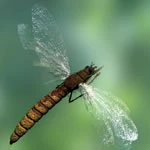
A falconfly is a type of wasp the size of a kestrel. Its grasping claws and barbed lance make it a formidable hunter.
The falconfly is a large, predatory ammophiline sphecid that inhabits the Antarctic Tropical Rainforest, descended from sand wasps that got blown over to Antarctica long ago, in the documentary The Future is Wild. It is one of the multiple species of large wasps of Antarctica as big as birds of prey that make light work of killing flutterbirds.
When a falconfly sees an unwary prey, such as a flutterbird, it dives to the attack. The hooked legs seize the bird, grasping its body through its feathers, and the second pair of legs lance like a harpoon deep into its internal organs (as well as using a venomous sting). With a squawk and a flurry of feathers, the two tumble through the branches and undergrowth and crash to the ground. There, the falconfly rips the victim to pieces with its powerful jaws. Such favored prey includes roachcutters.
Sometimes, this giant insect had a family to feed. A mother falconfly has three or four burrows scattered across the rainforest, each one containing a single developing larva, being 15-centimeter-long maggots (if they were in the same nest, they would cannibalize each other). Insects have always had several strategies for reproduction: some lay vast numbers of eggs, of which only a few survive; while others lay very few eggs but take special measures to ensure a high rate of survival. The falconfly pursues the latter course. A mother knows exactly where each of her larvae are hidden by memorizing familiar landmarks. She butchers the killed prey animal and shares out the body parts (such as the lumps of meat from a flutterbird) among her family.
Not all native birds are helpless against a falconfly. Spitfire birds can protect themselves by spraying hot acid at an attacking falconfly, driving the wasp away. At times, a falconfly might be fooled by the mimicked appearance of a false spitfire bird, believing it to be a true spitfire and wants to avoid the spray of hot acid.
